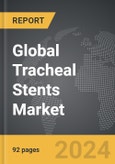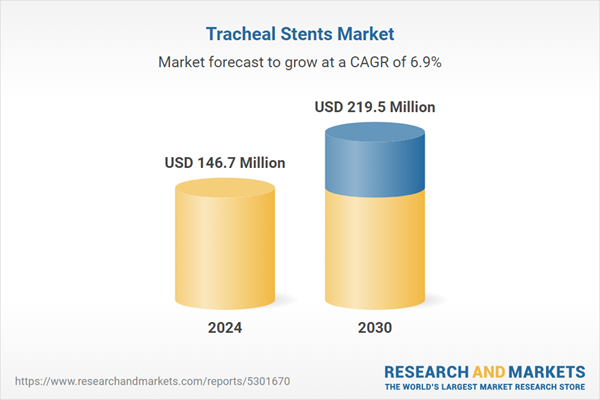Global Tracheal Stents Market - Key Trends & Drivers Summarized
What Are Tracheal Stents & Why Are They Crucial for Airway Management?
Tracheal stents are tubular medical devices designed to maintain an open airway in patients with tracheal obstructions or stenosis. Made from materials such as silicone, nitinol, or other biocompatible alloys, tracheal stents are used to stabilize the trachea and ensure unobstructed airflow in cases where the airway is narrowed due to tumors, trauma, inflammation, or congenital abnormalities. The stents can be either self-expanding or balloon-expandable, allowing them to adapt to the shape and size of the patient's trachea, providing immediate relief from airway constriction. They are crucial in managing conditions such as tracheal stenosis, tracheomalacia, and post-intubation injuries, offering a minimally invasive solution that can be temporary or permanent depending on the patient's condition. Tracheal stents play a vital role in both emergency and planned medical interventions, improving respiratory function and enhancing the quality of life for patients with airway obstructions.The increasing prevalence of respiratory diseases and conditions requiring airway management, such as chronic obstructive pulmonary disease (COPD), lung cancer, and tracheal collapse, has driven demand for tracheal stents. In emergency settings, tracheal stents can be rapidly deployed to restore airway patency, making them essential tools in critical care. They are also used as palliative solutions in patients with advanced lung cancer, providing relief from symptoms like dyspnea (shortness of breath) and improving overall respiratory capacity. As the global population ages, the incidence of respiratory diseases is rising, contributing to the growing demand for tracheal stents. The availability of stents in various sizes, materials, and designs enables tailored treatments that cater to individual patient needs, making tracheal stents indispensable in modern respiratory care.
How Do Tracheal Stents Improve Airway Management & Patient Outcomes?
Tracheal stents offer immediate and effective relief for patients with severe airway obstructions, making them critical in both acute and chronic respiratory management. These stents work by physically propping open the narrowed segment of the trachea, allowing for better airflow and reducing the risk of respiratory failure. Silicone tracheal stents, for instance, provide a rigid structure that is effective in maintaining the tracheal lumen, especially in patients with benign tracheal stenosis or tracheomalacia. On the other hand, metal-based stents, such as those made from nitinol, are designed to be self-expanding and flexible, adapting to the anatomy of the trachea and providing long-term stability in cases of malignant stenosis or recurring tracheal collapse. These stents can be placed using minimally invasive bronchoscopy, reducing the need for extensive surgery and associated complications, making them suitable for high-risk patients.The ability of tracheal stents to improve patient outcomes is evident in their use across a variety of clinical settings, from emergency care to palliative therapy. In addition to restoring airflow, these stents help alleviate symptoms such as wheezing, coughing, and difficulty breathing, significantly improving patients' comfort and daily function. They also reduce hospital stay duration, as stenting often leads to quicker recovery compared to more invasive surgical procedures. For patients with malignant conditions, tracheal stents can serve as palliative care tools, offering relief from respiratory distress and enhancing quality of life during advanced stages of disease. The role of tracheal stents in bridging treatment gaps for patients who are not candidates for surgery further underscores their importance in airway management. With proper placement and follow-up care, tracheal stents can provide long-lasting airway stability, reducing the frequency of interventions and improving overall respiratory health.
How Are Technological Advancements Shaping the Development of Tracheal Stents?
Technological advancements have led to significant innovations in the design, materials, and delivery systems of tracheal stents, making them more effective and safer for patients. One of the major innovations is the development of drug-eluting tracheal stents, which release medications such as anti-inflammatory drugs or chemotherapeutic agents directly into the trachea. These stents not only maintain airway patency but also help manage inflammation and prevent tumor regrowth, reducing the need for frequent stent replacements and additional interventions. The integration of biodegradable materials into stent designs is another significant advancement, offering temporary airway support that gradually degrades once the tracheal tissue stabilizes, minimizing the risk of long-term complications and the need for removal procedures.Additionally, advances in imaging technologies, such as 3D printing and patient-specific modeling, have enabled the creation of custom-fit tracheal stents tailored to individual patient anatomy. This personalization improves stent fit, reduces migration risks, and enhances overall patient comfort. Minimally invasive delivery systems have also evolved, allowing for easier deployment and repositioning of stents during bronchoscopy. Innovations in stent materials, such as nitinol alloys with memory properties, have improved stent flexibility, allowing for better adaptation to dynamic changes in airway size during breathing. The incorporation of anti-microbial coatings on stents is another area of development, aimed at reducing infection risks associated with prolonged stent placement. These technological advancements not only enhance the performance of tracheal stents but also expand their potential applications, making them safer and more effective in treating a wider range of airway conditions.
What Factors Are Driving Growth in the Tracheal Stents Market?
The growth in the tracheal stents market is driven by several factors, including the rising prevalence of respiratory diseases, increased demand for minimally invasive treatments, and advancements in stent technology. As respiratory diseases such as COPD, lung cancer, and tracheal stenosis become more common, the need for effective airway management solutions has grown significantly. Tracheal stents offer a less invasive alternative to surgery, making them particularly appealing for elderly patients and those with advanced comorbidities. The aging global population, which is more susceptible to respiratory ailments, further fuels demand for tracheal stents as part of long-term respiratory care. Moreover, the increasing use of stents in emergency settings and critical care has highlighted their importance in acute airway management, contributing to market growth.Advancements in stent design, such as drug-eluting and biodegradable options, have broadened the scope of tracheal stents in both therapeutic and palliative care. Regulatory approvals of new stent models, combined with improved reimbursement policies in many countries, have also encouraged healthcare providers to adopt stenting as a standard treatment for airway obstructions. Additionally, the expansion of healthcare infrastructure in emerging markets, coupled with growing awareness about advanced airway management, is creating new opportunities for tracheal stent manufacturers. The rise of telemedicine and remote patient monitoring has further supported the adoption of tracheal stents, as these technologies facilitate follow-up care and ensure timely management of potential complications. As innovations continue to enhance stent efficacy, patient safety, and procedural ease, the tracheal stents market is poised for sustained growth, driven by the need for better respiratory care solutions worldwide.
Report Scope
The report analyzes the Tracheal Stents market, presented in terms of market value (US$ Thousand). The analysis covers the key segments and geographic regions outlined below.- Segments: Material (Metal, Plastic, Other Materials).
- Geographic Regions/Countries:World; United States; Canada; Japan; China; Europe (France; Germany; Italy; United Kingdom; Spain; Russia; and Rest of Europe); Asia-Pacific (Australia; India; South Korea; and Rest of Asia-Pacific); Latin America (Argentina; Brazil; Mexico; and Rest of Latin America); Middle East (Iran; Israel; Saudi Arabia; United Arab Emirates; and Rest of Middle East); and Africa.
Key Insights:
- Market Growth: Understand the significant growth trajectory of the Metal Material segment, which is expected to reach US$154.2 Million by 2030 with a CAGR of a 7.4%. The Plastic Material segment is also set to grow at 6.3% CAGR over the analysis period.
- Regional Analysis: Gain insights into the U.S. market, valued at $38.2 Million in 2024, and China, forecasted to grow at an impressive 10.3% CAGR to reach $51.8 Million by 2030. Discover growth trends in other key regions, including Japan, Canada, Germany, and the Asia-Pacific.
Why You Should Buy This Report:
- Detailed Market Analysis: Access a thorough analysis of the Global Tracheal Stents Market, covering all major geographic regions and market segments.
- Competitive Insights: Get an overview of the competitive landscape, including the market presence of major players across different geographies.
- Future Trends and Drivers: Understand the key trends and drivers shaping the future of the Global Tracheal Stents Market.
- Actionable Insights: Benefit from actionable insights that can help you identify new revenue opportunities and make strategic business decisions.
Key Questions Answered:
- How is the Global Tracheal Stents Market expected to evolve by 2030?
- What are the main drivers and restraints affecting the market?
- Which market segments will grow the most over the forecast period?
- How will market shares for different regions and segments change by 2030?
- Who are the leading players in the market, and what are their prospects?
Report Features:
- Comprehensive Market Data: Independent analysis of annual sales and market forecasts in US$ Million from 2024 to 2030.
- In-Depth Regional Analysis: Detailed insights into key markets, including the U.S., China, Japan, Canada, Europe, Asia-Pacific, Latin America, Middle East, and Africa.
- Company Profiles: Coverage of players such as Bess Aktiengesellschaft (Bess AG), Boston Scientific Corporation, Cook Group, E. Benson Hood Laboratories, Inc., Efer Endoscopy and more.
- Complimentary Updates: Receive free report updates for one year to keep you informed of the latest market developments.
Some of the 36 companies featured in this Tracheal Stents market report include:
- Bess Aktiengesellschaft (Bess AG)
- Boston Scientific Corporation
- Cook Group
- E. Benson Hood Laboratories, Inc.
- Efer Endoscopy
- Endo-Flex GmbH
- Merit Medical Systems, Inc.
- Micro-Tech (Nanjing) Co., Ltd.
- Novatech SA
- Standard Sci. Tech, Inc.
- Stening SRL
- Taewoong Medical Co., Ltd.
This edition integrates the latest global trade and economic shifts into comprehensive market analysis. Key updates include:
- Tariff and Trade Impact: Insights into global tariff negotiations across 180+ countries, with analysis of supply chain turbulence, sourcing disruptions, and geographic realignment. Special focus on 2025 as a pivotal year for trade tensions, including updated perspectives on the Trump-era tariffs.
- Adjusted Forecasts and Analytics: Revised global and regional market forecasts through 2030, incorporating tariff effects, economic uncertainty, and structural changes in globalization. Includes historical analysis from 2015 to 2023.
- Strategic Market Dynamics: Evaluation of revised market prospects, regional outlooks, and key economic indicators such as population and urbanization trends.
- Innovation & Technology Trends: Latest developments in product and process innovation, emerging technologies, and key industry drivers shaping the competitive landscape.
- Competitive Intelligence: Updated global market share estimates for 2025, competitive positioning of major players (Strong/Active/Niche/Trivial), and refined focus on leading global brands and core players.
- Expert Insight & Commentary: Strategic analysis from economists, trade experts, and domain specialists to contextualize market shifts and identify emerging opportunities.
Table of Contents
Companies Mentioned (Partial List)
A selection of companies mentioned in this report includes, but is not limited to:
- Bess Aktiengesellschaft (Bess AG)
- Boston Scientific Corporation
- Cook Group
- E. Benson Hood Laboratories, Inc.
- Efer Endoscopy
- Endo-Flex GmbH
- Merit Medical Systems, Inc.
- Micro-Tech (Nanjing) Co., Ltd.
- Novatech SA
- Standard Sci. Tech, Inc.
- Stening SRL
- Taewoong Medical Co., Ltd.
Table Information
| Report Attribute | Details |
|---|---|
| No. of Pages | 177 |
| Published | December 2025 |
| Forecast Period | 2024 - 2030 |
| Estimated Market Value ( USD | $ 146.7 Million |
| Forecasted Market Value ( USD | $ 219.5 Million |
| Compound Annual Growth Rate | 6.9% |
| Regions Covered | Global |









